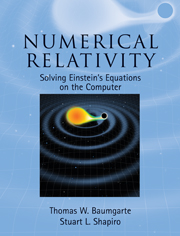Book contents
- Frontmatter
- Contents
- Preface
- Suggestions for using this book
- 1 General relativity preliminaries
- 2 The 3 + 1 decompostion of Einstein's equations
- 3 Constructing initial data
- 4 Choosing coordinates: the lapse and shift
- 5 Matter sources
- 6 Numerical methods
- 7 Locating black hole horizons
- 8 Spherically symmetric spacetimes
- 9 Gravitational waves
- 10 Collapse of collisionless clusters in axisymmetry
- 11 Recasting the evolution equations
- 12 Binary black hole initial data
- 13 Binary black hole evolution
- 14 Rotating stars
- 15 Binary neutron star initial data
- 16 Binary neutron star evolution
- 17 Binary black hole–neutron stars: initial data and evolution
- 18 Epilogue
- A Lie derivatives, Killing vectors, and tensor densities
- B Solving the vector Laplacian
- C The surface element on the apparent horizon
- D Scalar, vector and tensor spherical harmonics
- E Post-Newtonian results
- F Collisionless matter evolution in axisymmetry: basic equations
- G Rotating equilibria: gravitational field equations
- H Moving puncture representions of Schwarzschild: analytical results
- I Binary black hole puncture simulations as test problems
- References
- Index
10 - Collapse of collisionless clusters in axisymmetry
Published online by Cambridge University Press: 05 March 2013
- Frontmatter
- Contents
- Preface
- Suggestions for using this book
- 1 General relativity preliminaries
- 2 The 3 + 1 decompostion of Einstein's equations
- 3 Constructing initial data
- 4 Choosing coordinates: the lapse and shift
- 5 Matter sources
- 6 Numerical methods
- 7 Locating black hole horizons
- 8 Spherically symmetric spacetimes
- 9 Gravitational waves
- 10 Collapse of collisionless clusters in axisymmetry
- 11 Recasting the evolution equations
- 12 Binary black hole initial data
- 13 Binary black hole evolution
- 14 Rotating stars
- 15 Binary neutron star initial data
- 16 Binary neutron star evolution
- 17 Binary black hole–neutron stars: initial data and evolution
- 18 Epilogue
- A Lie derivatives, Killing vectors, and tensor densities
- B Solving the vector Laplacian
- C The surface element on the apparent horizon
- D Scalar, vector and tensor spherical harmonics
- E Post-Newtonian results
- F Collisionless matter evolution in axisymmetry: basic equations
- G Rotating equilibria: gravitational field equations
- H Moving puncture representions of Schwarzschild: analytical results
- I Binary black hole puncture simulations as test problems
- References
- Index
Summary
As we learned in Chapter 8, where we studied spherical systems, collisionless clusters provide a simple relativistic source for exploring the nature of Einstein's equations and experimenting with numerical techniques to solve them. Once we relax the restriction to spherical symmetry, the spacetimes can exhibit two new dynamical features: rotation and gravitational waves. Not much is known about nonspherical collisionless systems in general relativity, even for stationary equilibria. Some interesting results have emerged by exploiting numerical relativity to investigate the equilibrium structure and collapse of nonspherical rotating and nonrotating clusters in axisymmetry.1 To highlight the power of the technique, we shall summarize a few of the simulations and their key findings in this chapter.
The examples discussed below are chosen to demonstrate how numerical relativity, quite apart from providing accurate quantitative solutions to dynamical scenarios involving strong gravitational fields, can provide qualitative insight into Einstein's equations in those cases where uncertainty still prevails. It can even be helpful as a guide to proving (or disproving) theorems about strong-field spacetimes in those instances where analytic means alone have not been adequate.
Collapse of prolate spheroids to spindle singularities
It is well-known that classical general relativity admits solutions with singularities, and that such solutions can be produced by the gravitational collapse of nonsingular, asymptotically flat initial data. The Cosmic Censorship Conjecture of Penrose states that such singularities will always be clothed by event horizons and hence can never be visible from the outside (no naked singularities).
- Type
- Chapter
- Information
- Numerical RelativitySolving Einstein's Equations on the Computer, pp. 352 - 374Publisher: Cambridge University PressPrint publication year: 2010
- 1
- Cited by



